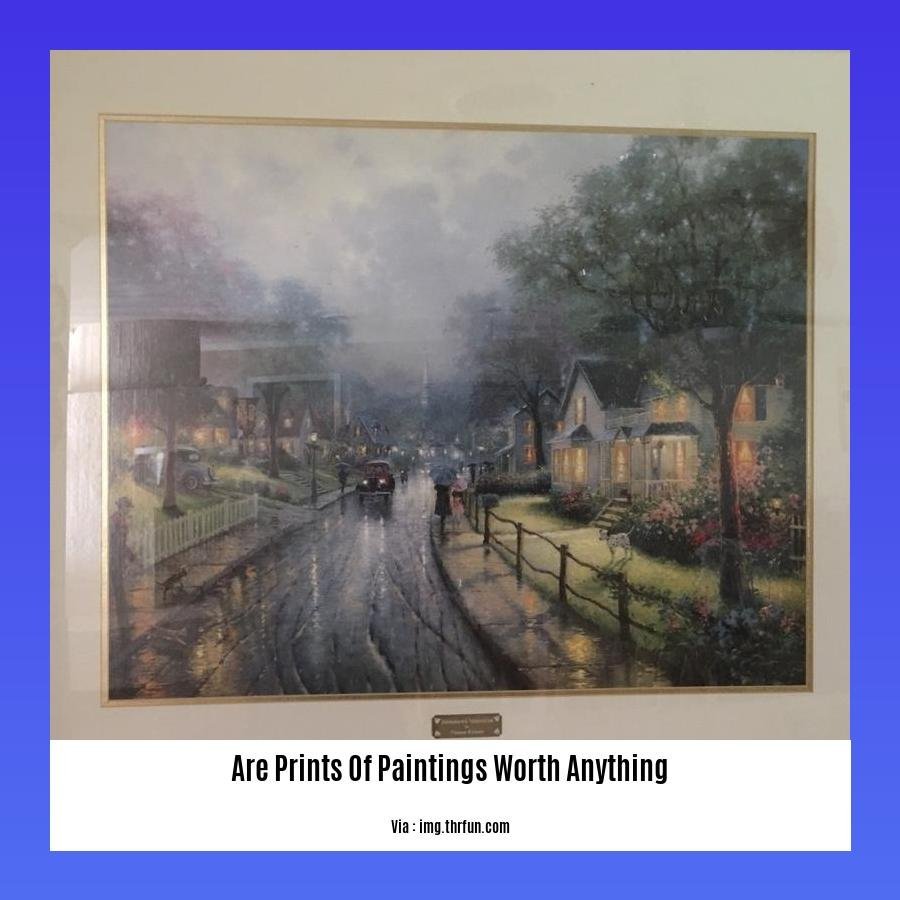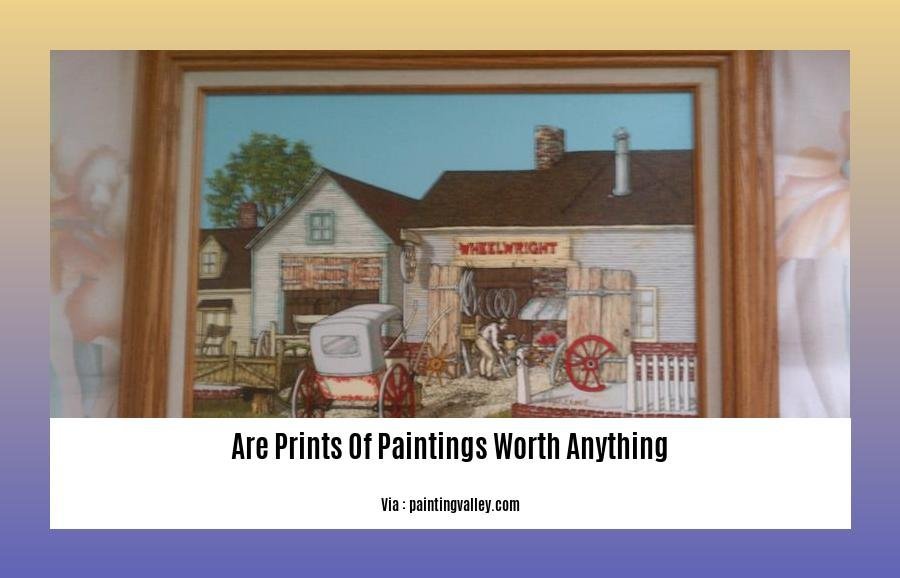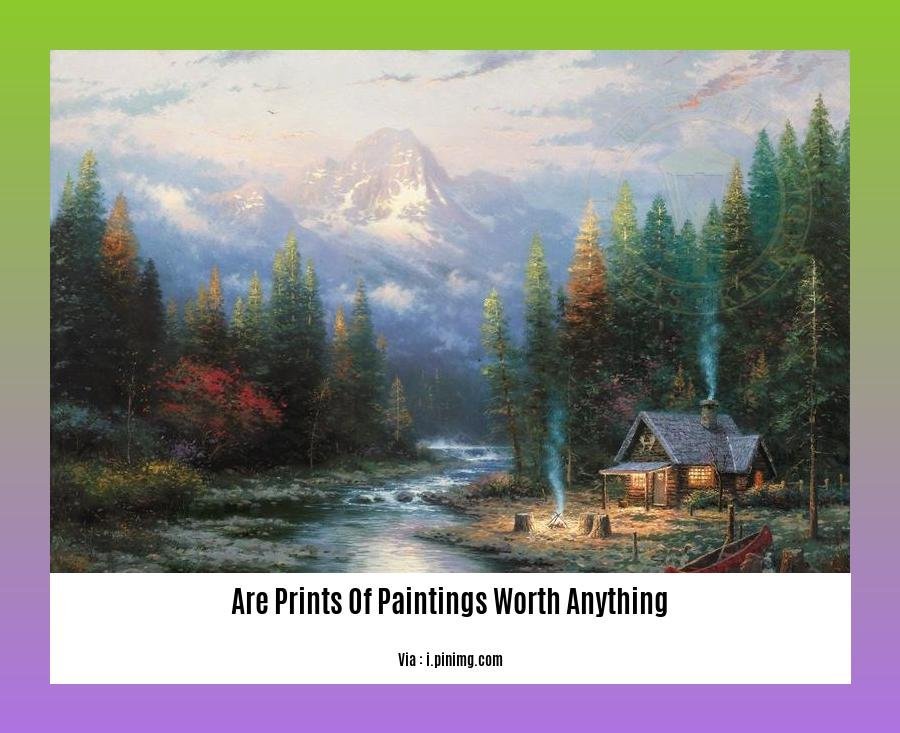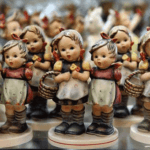Delve into the enigmatic world of art print valuation with [Are Prints of Paintings Worth Anything: Uncovering the Hidden Value in Reproductions]. Unravel the multifaceted factors that determine the worth of these artistic replicas, ranging from historical significance and rarity to technique and condition. Discover the hidden gems that lie within the vast ocean of prints, unlocking their potential to elevate your collection and enrich your understanding of the art market.
Key Takeaways:
A print of a painting typically has little value unless it’s a limited edition with the original artist’s signature.
Hand-painted reproductions can hold some value depending on quality, condition, presentation, and age.
Scarcity and availability impact value; limited edition prints with artist signatures are usually more valuable than mass-produced ones.
Labor-intensive or innovative printing techniques can enhance a print’s value.
Relevant URL Sources:
[Are Art Prints Worth Anything? Or Are You Wasting Money?] (https://wastedtalentinc.com/can-art-prints-be-valuable-or-a-waste-of-money/)
[How Much Is My Old Painting Worth? Reproduction vs. Original] (
Are Prints Of Paintings Worth Anything?

Determining the worth of a printed reproduction can be a puzzling endeavor. While some prints may appear aesthetically pleasing, their value often hinges on specific factors that can significantly impact their worth in the art market.
Scarcity and Limited Editions:
Rarity plays a pivotal role in determining a print’s value. Limited edition prints, typically signed and numbered by the artist, tend to carry more weight than mass-produced reproductions. The smaller the edition size, the scarcer the print becomes, consequently elevating its value.
Signature Matters:
An original artist’s signature can transform a print from a mere reproduction into a collectible piece. Not all reproductions bear an artist’s signature, so the presence of one can substantially increase its worth.
Technique and Quality:
The printing technique employed can also influence a print’s value. Labor-intensive or innovative methods, such as lithographs or serigraphs, often command higher prices than standard digital prints. Additionally, the overall quality of the print, including its condition and presentation, can impact its worth.
Artist Reputation:
The reputation and recognition of the artist directly correlate to the value of their prints. Prints by renowned artists typically fetch higher prices compared to those by lesser-known artists.
Provenance and Documentation:
A clear and well-documented provenance, tracing the print’s ownership history, can bolster its value. Additionally, certificates of authenticity or appraisals from reputable sources can further enhance a print’s credibility and worth.
Demand and Market Trends:
The art market is subject to trends and fluctuations, affecting the demand and, consequently, the value of prints. Prints aligned with current aesthetic preferences or those by artists experiencing a surge in popularity may command higher prices.
Determining A Print’s Value: Navigating the art market can be challenging. Consulting reputable art dealers, appraisers, or auction houses can provide valuable insights into a print’s worth. Additionally, extensive research, including examining comparable sales and staying informed about market trends, can help determine a print’s fair value.
Ultimately, the worth of printed reproductions is a complex interplay of various factors, encompassing scarcity, quality, artistic reputation, provenance, and market demand. Understanding these factors can empower collectors and enthusiasts to make informed decisions when navigating the world of art prints.
Understand the history behind the beautiful art of printmaking by clicking here: history of printmaking prints.
Travel back in time to uncover the origins of printmaking by following this link: When Did Printmaking Originate.
Discover the true value of original prints and why they’re worth investing in, right here.
Delve into the rich tapestry of printmaking’s history in art, with insights and revelations waiting for you here.
Explore the profound impact of printmaking on our society, revealing its significance and enduring legacy, here.
How to find a reputable dealer to purchase or sell a print

Let’s face it, the world of art collecting can be a real jungle, especially when it comes to prints. With so many options out there, how do you know who to trust? Finding a reputable dealer is key to making sure you’re getting a quality piece that’s worth your hard-earned cash.
Key Takeaways:
Credentials and Experience: Look for dealers who have a proven track record in the art market, with years of experience and a solid reputation. Check for memberships in professional organizations or accreditations that demonstrate their expertise.
Transparency and Honesty: A reputable dealer should be open and honest about the condition, provenance, and value of the prints they sell. They should be willing to provide detailed information about the artist, the edition size, and any relevant documentation.
Customer Service and Support: Pay attention to how the dealer interacts with you. Are they responsive to your inquiries? Do they provide clear and helpful information? A good dealer will go the extra mile to ensure your satisfaction.
Physical Location and Online Presence: While many reputable dealers have online platforms, having a physical gallery or showroom where you can view the prints in person is a big plus. This allows you to assess the quality and condition of the prints firsthand.
Pricing and Value: Be wary of dealers who offer prints at significantly lower prices than market value. This could be a red flag indicating questionable authenticity or condition. Trust dealers who price their prints fairly, based on factors like rarity, condition, and artist reputation.
Referrals and Recommendations: Ask fellow collectors, artists, or art professionals for recommendations. Personal referrals can be a great way to find reputable dealers who have a strong reputation in the art community.
Research and Due Diligence: Do your own research before making a purchase. Check online reviews, read articles and blogs about the dealer, and look for any red flags or negative feedback. A little due diligence can save you a lot of headaches down the road.
Trust Your Instincts: Ultimately, trust your instincts when choosing a dealer. If something feels off, it probably is. Go with a dealer who you feel comfortable with, who you believe is knowledgeable and trustworthy.
Legal and Ethical Considerations: Ensure that the dealer operates within legal and ethical boundaries. Check for proper licensing, permits, and compliance with local regulations. Support dealers who prioritize ethical practices, such as transparency in pricing and responsible sourcing of artworks.
Ongoing Relationship: Building a long-term relationship with a reputable dealer can be rewarding. Over time, they can become a trusted advisor, helping you grow your collection and make informed decisions about buying and selling prints.
Finding a reputable dealer is like finding a good friend – it takes time and effort, but the rewards are worth it. By following these guidelines, you’ll increase your chances of finding a dealer who you can trust to provide you with quality prints that are worth every penny.
[
[
Tips for Buying Prints
Hello there, my fellow art enthusiasts! Have you ever wondered if the prints of paintings have any monetary value? Well, let’s dive into the world of art prints and uncover the secrets behind their worth.
Key Takeaways:
- Limited Editions and Signed Prints: Prints in limited editions, especially those signed by the artist, hold more value than mass-produced reproductions.
- Technique and Quality: Specific printing techniques, like lithographs and serigraphs, can influence the value due to their labor-intensive nature. The overall quality and condition of the print also matter.
- Artist Reputation: Prints by renowned and established artists typically command higher prices compared to lesser-known artists.
- Provenance and Documentation: A well-documented history of ownership and authenticity, including certificates and appraisals, enhances the value of a print.
- Demand and Market Trends: Prints aligned with current aesthetic preferences or artists experiencing popularity may have higher monetary value.
Navigating the Print Market:
Buying art prints can be a rewarding experience, but it’s essential to approach it with knowledge and a keen eye for detail. Here are some valuable tips to help you navigate the print market successfully:
- Research: Delve into the artist’s background, previous sales, and the history of the print. Knowledge is power when it comes to making informed purchases.
- Seek Reputable Sources: Purchase prints from reputable art dealers, galleries, or reputable online platforms. This ensures authenticity and helps preserve the value of the print.
- Invest in Quality Framing: A high-quality frame can significantly enhance the value of the print. Choose frames that complement the style and period of the print.
- Store Prints Properly: Proper storage is crucial for maintaining the condition and value of prints. Choose a dry, temperature-controlled environment away from direct sunlight to prevent fading.
- Consult Experts: If you’re unsure about the authenticity or value of a print, consulting an art appraiser or expert can provide valuable insights and guidance.
Remember, the art world is dynamic, and values can fluctuate based on various factors. Stay informed about market trends, artist popularity, and economic conditions to make wise purchasing decisions. Whether you’re a seasoned collector or just starting, the world of art prints offers exciting opportunities for discovery and investment. Dive in, explore, and enjoy the beauty and value of these artistic treasures. Happy hunting!
Bonus Tip:
- Attend Art Fairs and Exhibitions: Art fairs and exhibitions provide a unique opportunity to view and purchase prints directly from artists and galleries. These events allow for personal interactions and firsthand insights into the creative process.
References:
Valuable Tips for Buying Art Prints
Art Prints: A Guide for Collectors
Tips for Selling Prints
Hey there, art enthusiasts and collectors! We’ve dived into the fascinating world of art prints, uncovering their hidden value and potential worth. But now, let’s switch gears and explore some valuable tips to help you successfully sell your art prints, maximizing their potential returns. Buckle up for a journey through the art market!
Key Takeaways:
Scarcity Sells: Limited edition prints, especially those with a low production run, carry more value. Think exclusivity!
Signature Matters: An artist’s autograph on a print elevates its worth. After all, it’s a personal touch that adds authenticity.
Research and Knowledge: Dive deep into the artist’s background, style, and market demand – knowledge is power!
Condition Counts: Preserve and protect your prints – proper storage and handling keep them in top condition, boosting their value.
Choose the Right Venue: Whether it’s an art gallery, online marketplace, or art fair, select a reputable platform that aligns with your target audience.
Price Wisely: Strike a balance between pricing your print competitively and reflecting its true worth. It’s a delicate dance!
High-Quality Images: Showcase your prints with high-resolution, well-lit photographs that capture their essence and details.
Storytelling Sells: Share the story behind the print, the artist’s inspiration, or any unique details that add value.
Provenance and Documentation: Provide clear documentation, including certificates of authenticity and a transparent ownership history. Trust builds value!
Network and Promote: Engage with art enthusiasts, galleries, and collectors. Spread the word about your prints through social media, art blogs, and exhibitions.
Patience Pays: Art appreciation can take time – don’t get discouraged if you don’t see immediate results. Persistence and patience often lead to success.
Remember, the art market is dynamic and influenced by a variety of factors. Stay informed about trends, evolving tastes, and economic conditions. Adapt your selling strategy accordingly, and you’ll increase your chances of finding appreciative buyers for your art prints.
Citations:
10 Tips for Selling Your Art Prints
FAQ
Q1: Are all prints of paintings valuable?
A1: Not all prints of paintings hold significant value. Several factors determine the worth of a print, including scarcity, availability, popularity, quality, and affordability.
Q2: What are the key factors that affect the value of art prints?
A2: The value of art prints primarily depends on scarcity, availability, popularity, quality, and affordability. Limited edition prints, especially those with low edition sizes, tend to have higher value. Signed and numbered prints are generally more valuable than unsigned prints.
Q3: How can I determine if a print of a painting is valuable?
A3: To determine the value of an art print, consider the artist’s reputation, the edition size, the condition of the print, and the current market demand. Consulting with an expert or appraiser can provide a more accurate assessment of the print’s worth.
Q4: Where can I find valuable prints of paintings?
A4: Valuable prints of paintings can be found in art galleries, antique shops, online marketplaces, and directly from artists. Reputable art dealers and auction houses can also offer valuable prints.
Q5: Is it worth investing in prints of paintings?
A5: Investing in prints of paintings can be a valuable decision, especially if you choose prints with potential for appreciation. Limited edition prints by renowned artists, particularly those with low edition sizes, can increase in value over time. However, the art market can be volatile, so it is crucial to conduct thorough research and consult with experts before making investment decisions.
- Mastering Leader in Spanish: The Complete Guide - April 19, 2025
- Uncovering Surprising Parallels: England Size Compared to US States - April 19, 2025
- Old Mexico Map: Border Shifts 1821-1857 - April 19, 2025
















